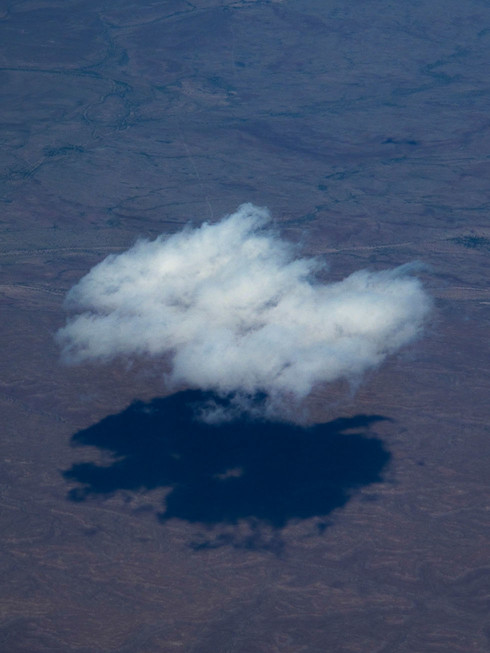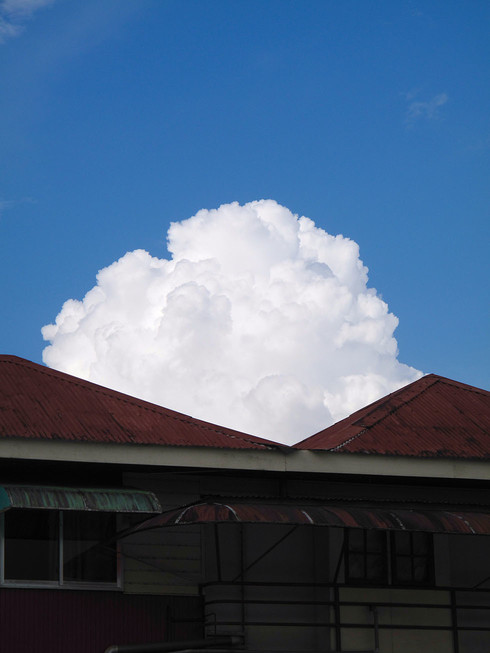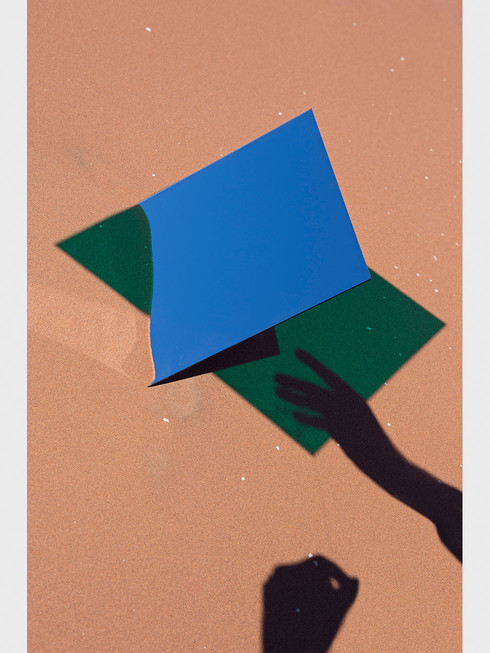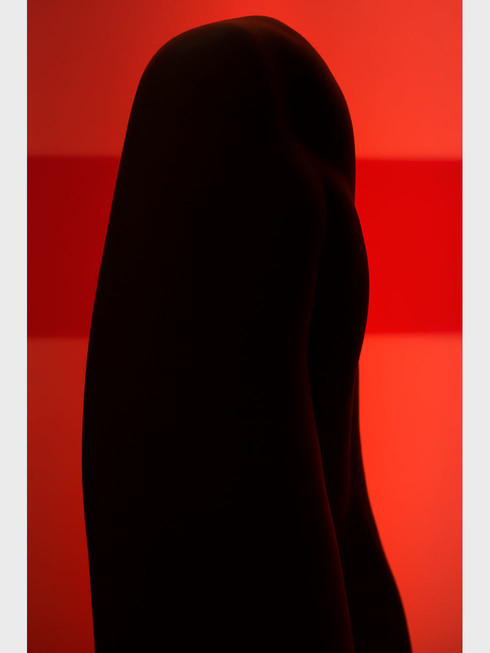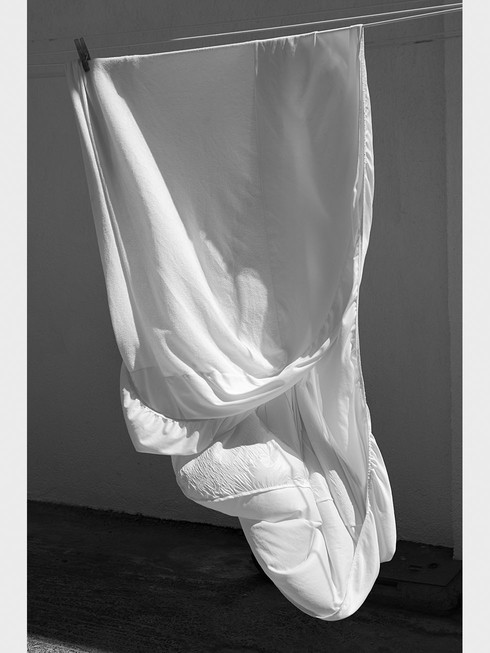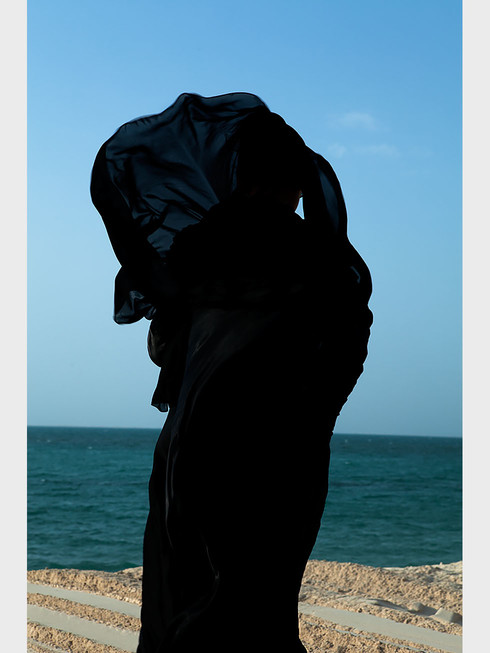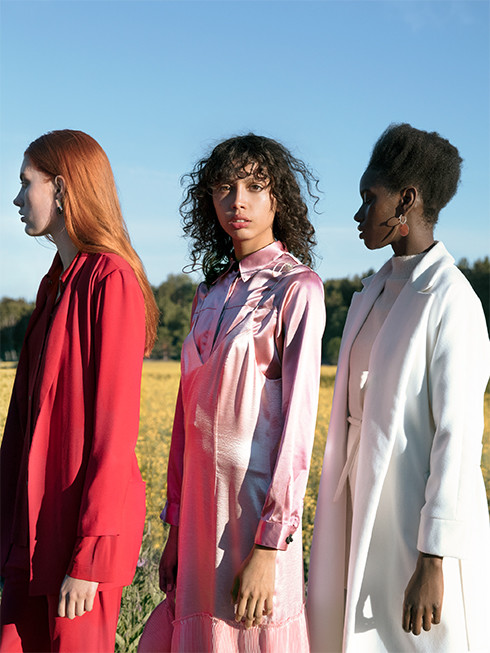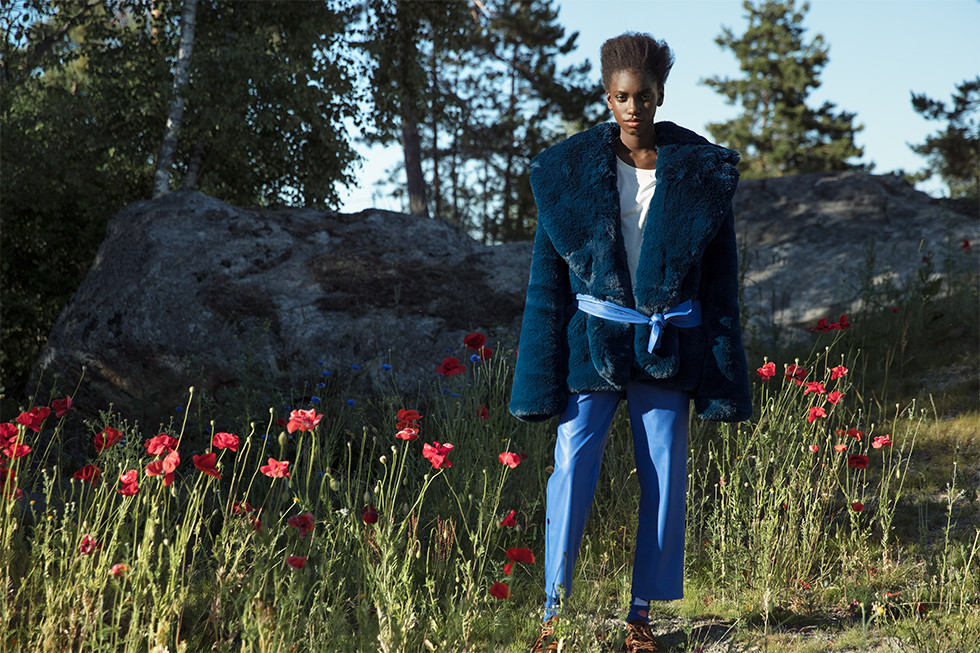Viviane Sassen
Written by Blenda Setterwa...While waiting for Viviane Sassen in the exhibition room at the Fotografiska Museet (Museum of Photography), in Stockholm, I have time for a private moment with the almost finished UMBRA exhibition. As much as I’ve read up on Viviane Sassen’s photography, something comes together in the dimly lit room, like a wordless message is being whispered from the walls. They trigger a sense of fusion and synecdoche in me, where all my senses become equally receptive. The sort of images that linger when you close your eyes and speak to a place in your mind where they might be mistaken for personal memories in the future.
UMBRA is full of contrasts and contradictions. A galanty show, color-popping sunlight, smoke, mirrors and frozen intimacy, capturing the space between the internal and external in us. Shadows of all shapes and sizes follow us like ghosts through the images. Pitch black and magnetic, sharply cut and graphic or thinly-spread like smoke and veils, all with a sense of gravity, mysticism and presence seen through Sassen’s camera lens.
As we sit down for the interview, Viviane Sassen - like her body of work - signals an alliance between contradicting forces. Genuine openness and curiosity paired with strong integrity and a piercing gaze.
V: I sometimes refer to myself back when I was younger as a shy exhibitionist. I think that in a lot of my work, there are paradoxes. Darkness and light, bold and subtle… there are all these contrasts. I feel drawn to both sides at the same time. Referring to myself as a shy exhibitionist sums it up. You want to show, you want to shine but at the same time you’re too shy to truly show your self. And I often feel drawn towards images that don’t show faces because I feel like they leave much more to the imagination. I like an image to not be… conclusive. To have an open end.
B: Something that lingers…
V: Yes. It makes you think about how you should perceive the image and what the story behind it is. In our subconscious we all have these universal ideas of what things are, how to register and categorize them, to be able to understand the outside world. And how that reflects back on our self. That’s constant, measuring between the self and the other.
B: What is your fascination with shadows?
V: I think the shadow stands for the unknown and I want to peek into the unknown. But it’s not about finding answers, it’s the curiosity itself. Maybe it is the fascination with the unknown. With darkness and with death, ultimately. And a fear of death that I have always had. My father was a doctor and worked in Africa. Later when we moved back to Holland, he had his practice in our house. There was always sickness and death nearby, it had something mysterious about it for me. And later on my father passed away, he ended his own life which was very tragic and something I can’t really understand. I think I still wonder what it’s like on the other side.
B: And the shadow is a portal?
V: A portal, yes. Without any answers.
B: Can you tell me how you made these glass photographies in the desert? They look Photoshopped, but they’re not?
V: No their not. It’s actually pieces of coloured prospects and a mirror. At least in the smaller once I used a mirror. And it was by accident that this happened because I set myself a goal to make a photographic version of the black square of Malevich. I had these really square things in mind and using the landscape. Almost like Rothko you know? All those references are there, but then I also brought a mirror, but I didn’t know what to do with it. At one point we were just resting a bit, drinking some water because we were in the desert in Namibia. When we put the mirror in the sand to free our hands, I saw the reflection of the sky. That was really beautiful! So we started experimenting with making shadows on top of the mirror. That is basically what you see. For instance that arrow here in the very corner, just a very thin line in the middle. That’s the mirror itself, seen from above. That dark piece on the right is the shadow of the mirror and the light piece is the reflexion of the sun in the mirror. They became very graphic, but I Like the human element in them, that you still see the shadows of the hand.
B: How and when did you know you wanted to express yourself through photography?
V: I think it was clear to me from a very young age that I wanted to do something creative, because I just couldn’t stop dreaming and drawing. That’s basically all I did. After high school it was pretty obvious that I would go to art school, but at the time I didn’t really know what I wanted to do or become. Or study. I thought maybe graphic design, maybe fashion design. I think the idea of becoming an artist was one step too far for me at the time, It was to vague and I needed something with more structure. So I decided to study fashion design, witch I did for two years. But I quite quickly realized that making clothes was not my passion, I wasn’t really interested in clothes that much. I’ve always had this kind of love/hate relationship with fashion. Like, not really interested but at the same time fashion photography always gave me a great platform to express myself, communicate and experiment with photography.
B: You started out as a model, that was your first encounter with the fashion industry. Do you think that affects your artistic expression in any way, that you have a double view?
V: Yeah, I think it had an influence on me back then. Just the fact that I worked with other creative people and could see how they set up a photograph, or the decisions they made. But I was still doing fashion design at that time and I realised that I wanted to be in control of the image. I also think that back then, it was a way of taking back the control of my own body. My own image and femininity. I worked with a lot of male photographers, they do have this “male gaze”. I felt as if many male photographers had these expectations of what a woman should look like, be like of behave like. I felt restricted by that. So It felt liberating to pick up the camera myself and make images of myself. Self portraits, nudes… exploring my own sexuality in a way, through images of friends and of myself.
B: A way of reclaiming?
V: Reclaiming, exactly. That’s exactly the right word.
B: You said that when you were younger you were mostly dreaming and drawing. I think that a lot of your pictures are like images you might see in your night-dreams. The moments you remember in flashbacks later on during the day.
V: Yes, I hear that a lot.
B: They go in through the subconscious sort of. When do you first see your images? Do you recreate pictures from memory?
V: It’s funny that you mention this. A lot of my images are created after I’ve had a dream at night and I wake up with just an idea or an image in my head that popped up. I sometimes make a drawing of it and have it as a lead to stage one of my pictures.
Of Course, the outcome will be different than how I saw it in my dream. Which is interesting because your mind is endless, you can think and invent anything, but with photography you still have to deal with reality. You need reality and things in order to make photographs. That paradox itself is interesting. In the process of making an image, new unexpected things happen that you would never have thought of beforehand. That makes it very exciting, to be surprised. It’s a way of trickyng the accident. Creating the conditions to allow accidents to happen.
B: Does that have to do with becoming more comfortable?
V: Yes, and more experienced. The great thing is that if you have all these years of experience, you gain the confidence to trust your own instincts and gut feeling. Which is great because then you gain this flow. You don’t worry anymore. Compare it to a musician who’s making music and is just in the moment, forgetting everything around. It’s tunnel vision, but it’s great.
B: Your pictures are so very sculptural. Have you ever been curious to try some other art form? Like sculpture? Or film?
V: I have been drawing for a long time, on the side. I don’t think I’m a very good drawer, but there are some little drawings over there. Then film, I’ve tried some stuff but I think it’s so complicated with my view of the world. It’s difficult to get the same quality. You have sound, time and narrative. That easily irritates me. If a photographer has too much narrative it becomes too literal. The way I compose my images is very sculptural. An image works in a specific moment in time and space, if it moves it changes and might lose it’s strength, or give too much information and become… prosaic or something.
B: You started as a photographer before Photoshop and have been along for the entire transition from analog to digital. What do you think has changed? In your way of working and in the artform in a broader sense?
V: It’s hard to imagine going back to how it was. I mean, a lot changed. I think I was very lucky to experience the whole turn-around. It was just this little tiny moment in time. When I was studying it was still all analogue so I was able to learn all those techniques, the tactility of it, the analogue process. Nowadays it’s more difficult to feel connected to the medium.
B: For the spectator or the photographer?
V: Both. I think that’s why young people go back to shooting analogue. Which for me doesn’t make much sense, I have to say. I mean, I understand it from the point of view of wanting to feel this connection with the medium in a stronger and more tactile way. I could go back to shooting more analogue, but I don’t feel the need. I think that the quality of the digital process and printing has become so good. In our collective conscience we have gotten used to the digital image. It took me a while, but now I don’t mind it any more. A lot of people think that analogue is up there, then there’s nothing, and then comes digital. The funny thing is that a lot of museums nowadays prefer to have good digital prints instead of analogue because they last longer. There are famous photographers, like Cindy Sherman who need to reprint all of their work from the 80’s because everything vanishes. The colours fade.
B: You went to art school for quite a long time.
V: Yes..
B: What was good about getting an extensive education in art?
V: I think time. Time itself. You don’t grow up overnight. You need to experience life.
I think that’s one of the problems and challenges that young people face nowadays, that it’s all so instant, so immediate, so fast. Because of social media, people have the feeling that they miss out on things or they need to be… you know…
B: Have something to show for themselves?
V: Yes! It’s a big pressure. We didn’t have all that information. I think maybe photography itself benefited from the overflow of images, because there are a lot of photographers out there and they all educate each other just by looking at eachothers images, but It’s also much more difficult for them to find their own voice. I mean, I studied fashion for two years, then photography for four years, then one year fine arts. And only then it started.
B: A protected time?
V: Yes, of experimentation. I can’t remember ever thinking about the future. We founded our own little magazine just as a way to get our work out into the world, we didn’t have anything else! Sometimes some shop in Amsterdam would sell fanzines like Purple Prose, Purple Fiction, Purple Fashion, Self Service, ID… I’d just send them colour copies of my prints and hope they’d want to work with me. And that happened, I just got a phone call, there was no email even!
I recently had this discussion with a young guy where I asked him “What would be your dream to make?” and he said, “Well, to make a little magazine with my friends.” And I thought, wow, for us it was completely the other way around! We made these little magazines to be able to get our work out as much as we could. They have the whole world as their platform, but want to make it more exclusive and intimate.
B: That sound so very nice, that you didn’t ever think about the future…
V: Yes, we were drinking coffee with friends for hours and hours and we didn’t think about the future. For years, we just hung out.
I think now, there’s much more pressure.
B: If you were to give advice, to for instance yourself back when you started, what would that be?
V: I think you have to be lucky in the sense that you have the time and space to develop as a person or artist.You need to have the creativity, but also the drive to make work. I see a lot of people who make some work every now and then but it doesn’t really come off the ground, they don’t have this urge to create. I think I have this inner drive, this passion to really make things and keep on making things and be curious. That helps.
We started with two classes, about 60 people. Then, we only graduated with 15-20 people and of the 15-20 people, maybe 4 or 5 are still working as a photographer. And from those 4 - 5 people there are not that many who have regular exhibitions.
But that isn’t very encouraging, maybe you shouldn’t write about that, ha ha!
Something that is more of an advice is that there are so many opinions, it’s not possible to make work that is appreciated by everybody. When I was doing my masters in fine arts we had artists and critics every week on studio visits. One would say one thing, and you’d think “Yeah ok he’s completely right”. The next day, someone else would come in and say the complete opposite. So in the end it doesn’t really matter, you have to make your own choices. Don’t be to concerned about being liked.
I’ve experienced periods in my life where I felt unable to make new work. I was too stuck in my head. But at some point I just thought, “Know what? It’s better that I go out there and take really bad pictures than not taking pictures at all.” I just picked up my camera and started photographing again. And little by little, step by step, you get something that you think is good, or could be different and have a new experience. There’s this saying in Holland, “ein hund die loopt find boten”. It means “a dog that walks find bones.” You see?
B: What do you think art could or should be? Getting that platform and reach, does it come with any obligations?
V: That’s a very difficult question. I’m not sure I’ll be able to answer that one. It’s a very important and profound question. On a very personal level it gives me reasons to live, making art is a way to sustain myself. Art is like a mirror, reflecting yourself and the outside world. In that sense it’s philosophical, not religious but spiritual. That’s why sometimes, if art is too theorised, too conceptual or too high brow, I tend to get bored.
I like to be able to connect on an emotional level. Solely on an intellectual level I loose interest.
B: What do you do if you feel uninspired?
V: The best trick is to travel. When you travel you see everything with new eyes. You’re much more aware, sharper eyes, ears… It’s like, if you have a photograph on your wall that you like, at some point you don’t really notice it anymore. It’s a pity because it’s there for a purpose, but at some point, as much as you love it you get used to it.
B; Home-blindness…
V: Yes.
B: Do you have favourite places to shoot where you like to return?
V: In general, I love it where the sun is shining. I love the sunlight, the brightness. And the shade. So I think that’s what’s most important for me, In a very literal sense.
B: What are you working on right now?
V: I’ve just finished a new body of work that is all about femininity. Womanhood and female strength. It’s about fertility and the female power to be able produce, feed and nourish. It’s about mushrooms, things growing… in a very organic way. And I’ve started drawing on pictures again, making collages. This (UMBRA) was kind of soul searching for me. Revisiting the death of my father. This whole series about shadows. Then I felt completely open, and now there’s space for other adventures and to be really playful and intuitive again.
B: That picture, that is your son and your shadow? What does it mean to you?
V: That picture is very important to me. It symbolises the fact that we as parents always put a shadow on our own children. In a good or a bad way, somehow we’re always influenced by our parents, even if they’re absent, it’s in our DNA. And I also like that this picture is a view into the future, to the moment when he will have long legs like that.
B: It kind of relates to what you’re doing now, with parenthood?
V: Yes! But what I do now is a lot more frivolous and bold.
B: When and where can we see it?
V: I did an exhibition at Stevenson gallery in Johannesburg, and there’s one coming up in Tokyo in October and there will be a book made by the japanese gallery. It’s called “Of mud and Lotus”.
B: You’re very good with titles and words, I think.
V: Thank you!
B: I’m curious about the cloud-picture, can you tell me how it happened?
V: This was in suriname, at a really weird empty swimming pool. I saw this cumulus cloud coming up, and I tried to connect the line of the cloud with the line of the roof. And somehow, for me it relates to the idea of rebuses. There are certain messages in these pictures, you can’t really grasp what their meaning is but they have something that they want to tell you. Like getting messages from somewhere.
B: You see them all like rebuses?
V: Yes. Or like words. They form sentences or poems or stories. I’ve always been very interested in the fact that you can take a picture out of one context and put in in a different one, and it will mean something else. You can form different sentences with images. Taking away and adding. Like in a rebus.


